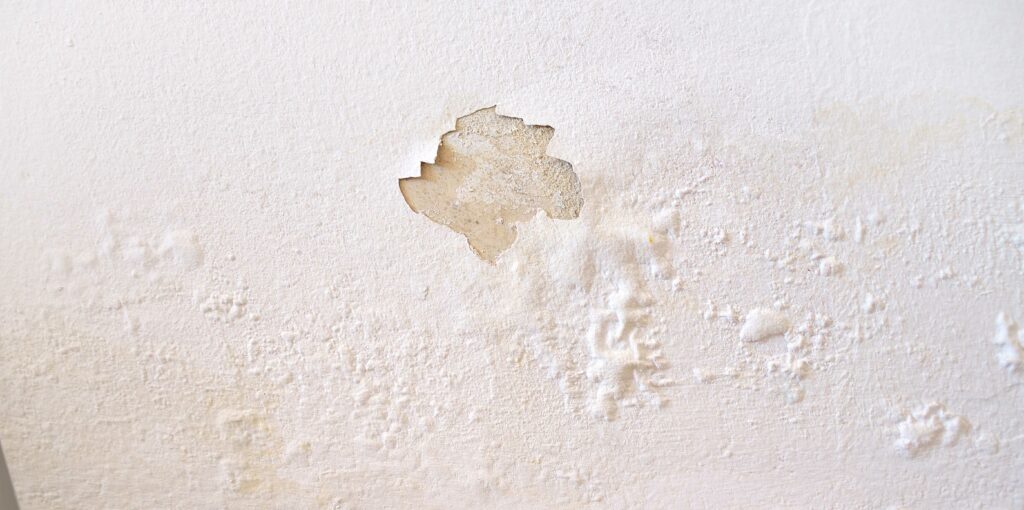Wet Drywall Can Cause Mold Infestation in Springfield Missouri
Whenever you get a small water leak behind a wall or inside your ceiling, it can often go undetected for a long period of time. Your first clue that there’s actually a problem is when paint finally begins to bubble or there’s a stain in your drywall.
Once you notice that there’s a problem, you’ll need to take action as soon as possible. Because that leak has likely been ongoing for awhile and you need to figure out where the water is coming from, how much hidden damage it has caused and what you need to do to make sure it doesn’t happen again.
As a general rule, most of the building materials in your home need to remain dry to keep their structural integrity. Some items are designed to repel water like your kitchen countertops, but drywall is called that for a reason. It needs to stay dry.
You don’t want your drywall having a high moisture content, because that can quickly lead to a mold infestation in Springfield Missouri and then you have a much bigger problem to deal with than just finding the source of the water leak.
You can also have issues with mold or warping if your wood trim or flooring gets wet. But drywall is especially troublesome because it loses its structural integrity when it gets wet. Drywall acts like a sponge to soak up water rather than repel it. This allows mold to start growing inside your walls and ceiling.
Unless you have a pipe burst, most water leaks can go undetected for a long period of time. A leak in your roof, a water line from your refrigerator or condensation from your HVAC can generate excess moisture that can go unnoticed for a while.
If those leaks aren’t caught quickly, then the drywall that gets wet will probably need to be removed before you have a big mold infestation to deal with.
We sometimes get asked what constitutes a “safe” moisture level in your wall. When testing your walls for moisture, we would prefer it to read 0%, meaning your wall is nice and dry and has probably never been wet in any way.
That doesn’t mean that anything above that would require your drywall to be removed and replaced, but we’d love for it to be bone dry.
If our moisture meter does show a moisture reading above 0%, then we would prefer that number to be in single digits and for there to be a reason that it got wet at all.
If it is in single digits and we can verify that there was a recent leak that is now fixed, then there’s a good chance that this area can be dried out and your drywall won’t need to be replaced.
Hopefully within a couple of weeks, you can test the area again with a moisture meter and that number will be even lower and you won’t be at a high risk for mold growth to occur.
Note that not all moisture meters are created equal. Mold and waterproofing professionals, like Dog Gone Mold and Dog Gone Waterproofing, have commercial grade, reliable moisture meters to detect moisture without having to remove building materials.
Our moisture meters are superior to the $20 moisture meter you can by at your local hardware store, so make sure to have a professional test your drywall if you notice any issues.
But if you don’t know why there is moisture in the wall or ceiling, then getting to the root cause of the problem needs to be your top priority.
If that can’t be figured out from the outside, then we would recommend removing that section of drywall, because you may have a leaky pipe behind that wall, or a leak from above.
Better to err on the side of being a little more invasive to not only find the root source of the water intrusion, but also be able to see inside how much damage has been done and if you have a mold infestation that needs to be addressed.
We will always recommend removal of any drywall if the moisture content is in the double digits. Drywall is relatively inexpensive to remove and replace and it’s not worth the risk of mold growth occurring. This can be a much larger, more expensive fix then some minor drywall replacement.
If you need help keeping water our of your house, our team at Dog Gone Waterproofing can help you come up with the best plan for keeping your home dry. And if the wet drywall has led to a mold infestation, our Dog Gone Mold team can get rid of it with mold remediation.
If you ever notice any bubbling paint or stains on your drywall, contact the team at Dog Gone Mold to come out and do an inspection to get to the root cause of the problem, make sure it doesn’t come back and fix any problems that the wet drywall has caused.
